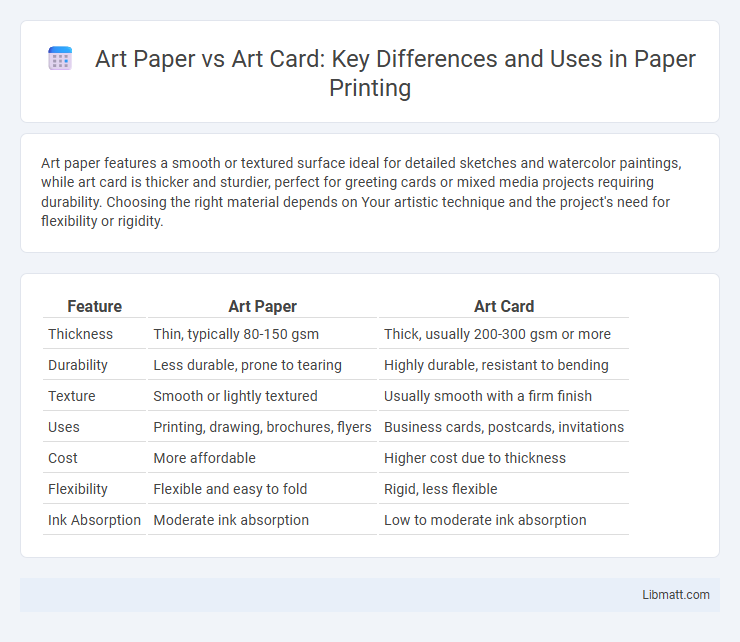Art paper features a smooth or textured surface ideal for detailed sketches and watercolor paintings, while art card is thicker and sturdier, perfect for greeting cards or mixed media projects requiring durability. Choosing the right material depends on Your artistic technique and the project's need for flexibility or rigidity.
Table of Comparison
| Feature | Art Paper | Art Card |
|---|---|---|
| Thickness | Thin, typically 80-150 gsm | Thick, usually 200-300 gsm or more |
| Durability | Less durable, prone to tearing | Highly durable, resistant to bending |
| Texture | Smooth or lightly textured | Usually smooth with a firm finish |
| Uses | Printing, drawing, brochures, flyers | Business cards, postcards, invitations |
| Cost | More affordable | Higher cost due to thickness |
| Flexibility | Flexible and easy to fold | Rigid, less flexible |
| Ink Absorption | Moderate ink absorption | Low to moderate ink absorption |
Introduction to Art Paper and Art Card
Art paper typically features a smooth or textured surface designed for detailed illustrations and high-quality printing, making it ideal for watercolor, ink, and charcoal artworks. Art cards are thicker and more rigid than regular art paper, offering enhanced durability and a sturdy base suitable for greeting cards, postcards, and art prints. Both materials cater to different artistic needs, with art paper prioritizing finesse and art cards emphasizing strength and presentation.
Key Differences Between Art Paper and Art Card
Art paper typically features a smooth or textured surface designed for drawing, painting, and printmaking, offering better ink absorption and detail precision, while art card is thicker and more rigid, ideal for projects requiring durability like greeting cards or postcards. The weight of art card generally ranges from 200 to 400 gsm, providing sturdiness, whereas art paper varies between 80 to 200 gsm, prioritizing flexibility and ease of handling. Your choice between art paper and art card should consider the desired finish, thickness, and intended use to ensure compatibility with your artistic technique and project requirements.
Physical Properties and Texture Comparison
Art paper typically features a thinner weight ranging from 80 to 200 gsm, offering a smooth or lightly textured surface ideal for detailed ink and digital prints. Art card is heavier, often between 200 to 350 gsm, with a rigid structure and a more pronounced texture such as matte or linen, enhancing tactile appeal and durability. The difference in thickness and surface texture influences their suitability for framing, greeting cards, and other fine art applications where rigidity and texture impact visual and physical presentation.
Common Uses in Art and Printing
Art paper is commonly used for detailed illustrations, watercolor paintings, and high-quality printing projects requiring smooth, absorbent surfaces, making it ideal for fine art prints and posters. Art card, thicker and more rigid, is preferred for creating business cards, greeting cards, invitations, and packaging where durability and sturdiness are essential. Both materials support various printing techniques, but art card's density lends itself better to projects needing structural integrity and tactile presence.
Durability and Longevity of Materials
Art card features greater thickness and sturdiness compared to art paper, offering enhanced durability for projects requiring longevity. Its rigid construction resists bending, warping, and moisture damage, making it ideal for framing or long-term display. Your choice between art paper and art card should consider how well the material maintains its integrity over time under environmental stress.
Print Quality: Colors and Details
Art paper offers superior print quality with vibrant colors and sharp details, making it ideal for professional-grade prints and fine art reproductions. Art card, while thicker and sturdier, may slightly compromise on color depth and detail precision due to its textured surface. Choosing the right material depends on whether your priority is exquisite color fidelity or durability.
Cost Considerations: Art Paper vs Art Card
Art paper generally costs less than art card due to its thinner weight and lighter texture, making it ideal for bulk projects and affordable prints. Art card, characterized by its thicker, sturdier surface, is priced higher but offers enhanced durability and a premium feel suitable for professional presentations or high-quality art prints. Your choice depends on budget constraints and the desired longevity or texture of your artwork.
Environmental Impact and Sustainability
Art paper typically has a higher environmental impact due to its production from wood pulp, often involving chemical treatments and energy-intensive processes that contribute to deforestation and pollution. Art cards, especially those made from recycled or sustainably sourced materials, generally have a lower carbon footprint and promote recycling efforts by minimizing waste. Choosing certified eco-friendly art cards supports sustainable forestry practices and reduces environmental degradation compared to conventional art papers.
Choosing the Right Material for Your Project
Selecting between art paper and art card hinges on the project's durability and texture requirements. Art paper offers a smoother surface ideal for detailed illustrations and watercolor, while art card provides sturdiness and a thicker feel suitable for postcards, invitations, and mixed media projects. Evaluating the desired finish, weight, and application will guide you to the optimal material for professional-quality results.
Conclusion: Which One Should You Choose?
Art paper offers a lightweight, smooth surface ideal for detailed sketches and ink work, while art cards provide a sturdier, thicker base suitable for painting, stamping, and mixed media projects. Your choice depends on the medium and durability you need; opt for art paper for fine lines and delicate work, and art card for a robust, professional finish. Selecting the right material enhances the quality and longevity of your artwork, making your creative process more satisfying and effective.
art paper vs art card Infographic

 libmatt.com
libmatt.com